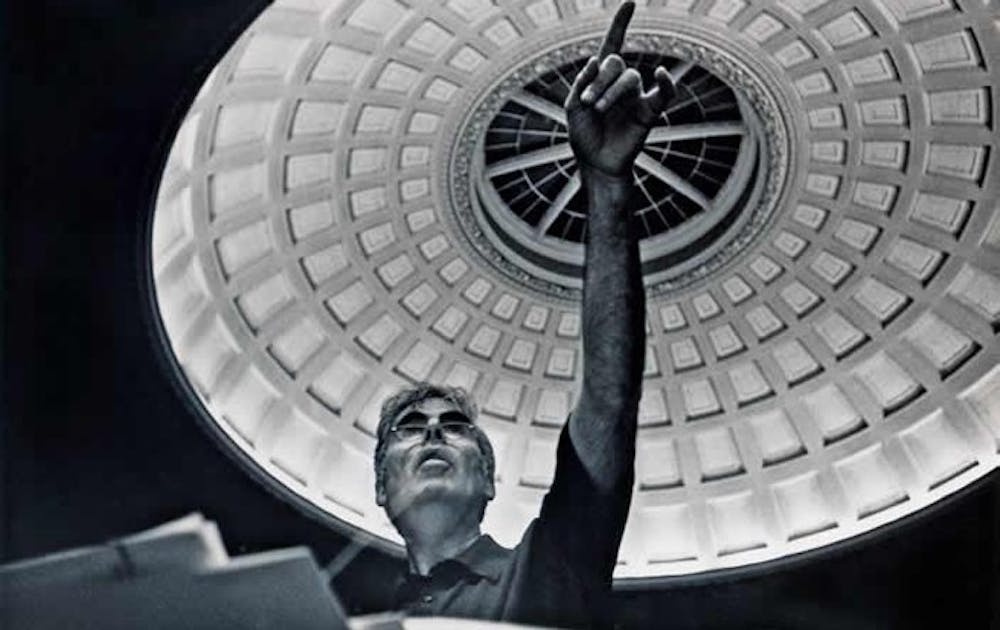It’s hard to talk about the history of the Duke Wind Symphony without mentioning Paul Bryan. Among alumni who played under him during his thirty-eight year tenure, his status is legendary. Part musicologist, part conductor, the man who students call P.B. presided over many of the symphony’s most thriving years. He envisioned, planned and eventually led five semester-long concert tours and study abroad programs in Vienna, Austria for DWS members. A relentless advocate for the creation of compositions made especially for wind symphonies, he commissioned pieces by some of the most famous American composers for concert bands, many of which, including Norman Dello Joio’s “Variants on a Medieval Tune,” have been played by symphonies around the world. He’s published numerous academic articles on Haydn and Mozart, helped run Durham’s Youth Symphony and, even though he’s turning 93 in April, still plays the euphonium at many of the Duke Wind Symphony’s twice-weekly rehearsals. In 2008, former students of his worked with him to publish a book about his life and work under the apt title P.B., Who He?: Teacher, Not-your-usual Band Conductor, Musicologist and Human Being.
Despite his many accomplishments, it’s that last quality, P.B.’s generous humanity, that I’ve heard spoken about most enthusiastically by his friends and colleagues. “He’s such a wonderful person,” said Verena Mösenbichler-Bryant, current director of the DWS. “I just want to give a little back for what he’s given me.”
On Apr. 18 at 8 p.m., Mösenbichler-Bryant and many DWS members both past and current will have that opportunity. The date marks the group’s second concert of the semester, a concert that will be dedicated to P.B. and his lasting impact. The group will perform pieces that P.B. conducted during his first concert at Duke, as well as some of the pieces that he commissioned and some of his personal favorites. Mösenbichler-Bryant has hinted that P.B. will take the podium for at least one of the pieces, conducting once more, and P.B. himself will likely play his euphonium. Alumni living as far away as Russia have RSVP’d to play with the Symphony during April’s concert. Many of these same alumni have stayed in contact with P.B. well after their time at Duke.
“His memory for all of his students is just incredible,” said Shauna Farmer, Trinity ’86, who played bassoon with the symphony. “He makes me feel like I’m someone special, but in the grand scheme of things, he probably keeps in touch with dozens of students. He really cared about all of us.”
P.B. has a catalog of stories about times he has had with his students, and it’s clear that they are as important to him—if not more important—than the music he helped to make. “It took an enormous amount of energy, but I loved the students—they were so responsive—and it was like falling in love,” P.B. said about his first trip to Vienna.
When I talked with P.B., he regularly returned to experiences he had abroad with the symphony. On his first trip to Vienna with the group, he remembers playing in the best concert hall and reading a review by an Austrian critic that said that the students played with “an exemplary precision one doesn’t hear in this land” even though only a few were interested in becoming professional musicians. “I think we were the first serious American wind band to go [to Vienna] and play,” P.B. said. Throughout his time at Duke, the symphony toured many other major European cities, and the large group photos of students in ’70s-era attire and assorted concert posters hanging in Mösenbichler-Bryant’s office in the Mary Duke Biddle Music Building attest to their presence abroad.
Inspired by P.B.’s trips, Mösenbichler-Bryant hopes to reinstate the practice of touring that had stopped in recent decades. This fall, DWS is scheduled to perform in Atlanta, which, though not exactly Europe, should allow the young director an opportunity to practice touring before planning more extended, possibly international trips in the future. Her enthusiasm about touring is only one of the similarities between Mösenbichler-Bryant and P.B. “She’s really grabbed the students,” P.B. said. “She’s vital, and she’s a very good conductor.” Those are the kind of qualities that have helped her to grow the DWS back to over 60 musicians from a low-point of 30 just before she was hired. “Before I came here I was told this was the last chance for the Wind Symphony to thrive again,” said Mösenbichler-Bryant. “So far it seems like we have continuity again. It’s getting closer to how it was in P.B.’s time.”
It’s tempting to think about the concert as an event that passes the baton from the legacy of P.B.’s reign to the new DWS under Mösenbichler-Bryant. But it’s probably more appropriate to view it simply as an opportunity to pay tribute to a man who has done so much for the Symphony. “Alumni players have told me that for them he is the Duke Wind Symphony,” Mösenbichler-Bryant said. April’s concert is the ultimate chance to both honor P.B.’s central and lasting role in building the DWS and to convince those very alumni that the group will outlast him.
The Duke Wind Symphony performs A Concert Dedicated to Paul Bryan April 18 at 8 p.m. in Page Auditorium. Admission is free. There will be a celebratory reception after the concert at which audience members can meet P.B.
Get The Chronicle straight to your inbox
Signup for our weekly newsletter. Cancel at any time.

